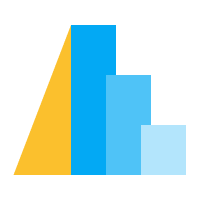图像#
图像标记允许将外部图像(例如图标或照片)包含在 Altair 可视化中。诸如 PNG 或 JPG 图像文件可以从提供的 URL 加载。
图像标记属性#
一个 image 标记可以包含任何标准标记属性和以下特殊属性
点击显示表格
属性 |
类型 |
描述 |
|---|---|---|
url |
图像标记的图像文件 URL。 |
|
aspect |
anyOf( |
是否保持图像标记的宽高比。 |
align |
文本或范围标记(area, bar, image, rect, rule)的水平对齐方式。可选值为 注意:范围标记不支持表达式引用。 |
|
baseline |
anyOf( |
对于文本标记,垂直文本基线。可选值为 对于范围标记,标记的垂直对齐方式。可选值为 注意:范围标记不支持表达式引用。 |
带有图像标记的散点图#
import altair as alt
import pandas as pd
source = pd.DataFrame.from_records(
[
{
"x": 0.5,
"y": 0.5,
"img": "https://vega.github.io/vega-datasets/data/ffox.png",
},
{
"x": 1.5,
"y": 1.5,
"img": "https://vega.github.io/vega-datasets/data/gimp.png",
},
{
"x": 2.5,
"y": 2.5,
"img": "https://vega.github.io/vega-datasets/data/7zip.png",
},
]
)
alt.Chart(source).mark_image(width=50, height=50).encode(x="x", y="y", url="img")
显示带有选择的图像标记#
此示例演示了如何使用拖动选择来显示图像标记。我们创建两个图表:一个使用点标记,另一个使用图像标记,仅将选择筛选器应用于后者。通过组合这两个图表,我们可以达到预期的效果。
import altair as alt
import pandas as pd
source = pd.DataFrame.from_records(
[{'a': 1, 'b': 1, 'image': 'https://vega-altair.cn/_static/altair-logo-light.png'},
{'a': 2, 'b': 2, 'image': 'https://avatars.githubusercontent.com/u/11796929?s=200&v=4'}]
)
brush = alt.selection_interval()
point = alt.Chart(source).mark_circle(size=100).encode(
x='a',
y='b',
).add_params(
brush
)
img = alt.Chart(source).mark_image(width=50, height=75).encode(
x='a',
y='b',
url='image'
).transform_filter(
brush
)
point + img
在分层图表中,图像可能会相互重叠。另一种方法是在原始图表旁边使用分面图像图表。
img_faceted = alt.Chart(source, width=50, height=75).mark_image().encode(
url='image'
).facet(
alt.Facet('image', title='', header=alt.Header(labelFontSize=0))
).transform_filter(
brush
)
point | img_faceted
如果我们希望图像在初始图表中不可见,可以在区间选择中添加 empty=False。然而,当进行选择时,Altair 不会自动调整图表区域以包含分面图表,这意味着选择看起来没有效果。为了自动调整图表大小,我们需要在 configure 方法中显式设置 autosize 选项。
brush = alt.selection_interval(empty=False)
point = alt.Chart(source).mark_circle(size=100).encode(
x='a',
y='b',
).add_params(
brush
)
img_faceted = alt.Chart(source, width=50, height=75).mark_image().encode(
url='image'
).facet(
alt.Facet('image', title='', header=alt.Header(labelFontSize=0))
).transform_filter(
brush
)
(point | img_faceted).configure(
autosize=alt.AutoSizeParams(resize=True)
)
使用本地图像作为图像标记#
我们还可以通过先将本地图像转换为base64 编码字符串来显示它们。在下面的示例中,我们加载了 Altair 仓库中保存的两张图像;您可以将下面的图像路径替换为您机器上所需图像的位置。此方法也适用于存储为 Numpy 数组的图像,如教程在工具提示中显示 Numpy 图像所示。
import base64
import altair as alt
import pandas as pd
from io import BytesIO
from PIL import Image
image_paths = ["doc/_static/gray-square.png","doc/_static/altair-logo-light.png"]
base64_images = []
for image_path in image_paths:
pil_image = Image.open(image_path)
output = BytesIO()
pil_image.save(output, format='PNG')
base64_images.append(
"data:image/png;base64," + base64.b64encode(output.getvalue()).decode()
)
source = pd.DataFrame({"x": [1, 2], "y": [1, 2], "image": base64_images})
alt.Chart(source).mark_image(
width=50,
height=50
).encode(
x='x',
y='y',
url='image'
)
图像工具提示#
此示例展示了如何在工具提示中渲染图像。可以使用 URL 或本地文件路径来引用图像。要渲染图像,您必须在数据中使用特殊的列名“image”,并将其作为列表传递给工具提示编码。
import altair as alt
import pandas as pd
source = pd.DataFrame.from_records(
[{'a': 1, 'b': 1, 'image': 'https://vega-altair.cn/_static/altair-logo-light.png'},
{'a': 2, 'b': 2, 'image': 'https://avatars.githubusercontent.com/u/11796929?s=200&v=4'}]
)
alt.Chart(source).mark_circle(size=200).encode(
x='a',
y='b',
tooltip=['image'] # Must be a list containing a field called "image"
)
